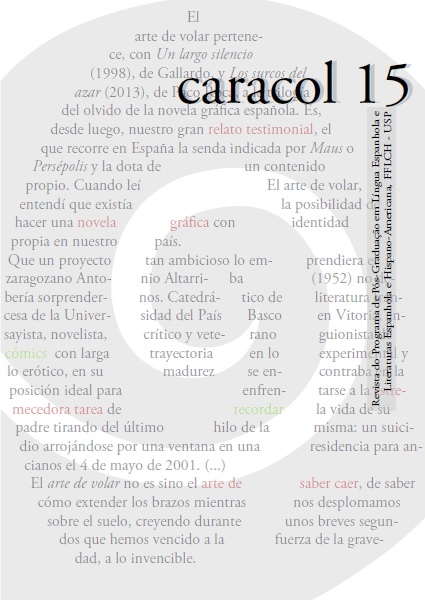Pablo De Santis and the police officer in comic strips: theory and practice
DOI:
https://doi.org/10.11606/issn.2317-9651.v0i15p162-187Keywords:
Pablo De Santis, Historieta, Género policial, Narrativa argentinaAbstract
I propose an interpretation based on the ways in which detective fiction is presented and represented in comics and essays by Pablo De Santis. In the first place, I maintain an hypothesis that allows to unite his comic and essays’s productions with his “adult” literature, based on two arguments: on the one hand, the detective fiction genre unites the two narratives; on the other, they differ in the fact that his literature is closer to the classic detective fiction, while his comics tend to approach the hard-boiled fiction. Secondly, I review some of De Santis’s theories about comics, mainly those linked with the hard-boiled fiction, the preeminence of the urban environment and the question of how to make a national detective literature. Finally, according to my hypothesis on detective fiction, I analyze his scriptwriting practice in two comic books published in 2016: Justicia poética y Cobalto.
Downloads
References
Altman, Rick. Los géneros cinematográficos. Barcelona: Paidós, 2000.
Chandler, Raymond. “El simple arte de matar”. El simple arte de matar. Buenos Aires: Tiempo Contemporáneo, 1970. 187-206.
Dashiell Hammett, Samuel. Cosecha roja. Novelas escogidas, Madrid: Aguilar, 1962.
De Santis, Pablo. Historieta y política en los ‘80. La Argentina ilustrada. Buenos Aires: Letra Buena, 1992.
___. La traducción. Buenos Aires: Planeta, 1998a.
___. La historieta en la edad de la razón. Buenos Aires: Paidós, 1998b.
___. “Crímenes ilustrados”. La Puerta FBA. Revista de Arte y Diseño, Nº 2, 2006. 51-55.
___. “Hotel Insomnio”. El hipnotizador. Dibujado por Juan Sáenz Valiente. Buenos Aires: Mondadori, 2012 [2010]. 5-7.
___. Crímenes y jardines. Buenos Aires: Planeta.
___. “Carlos Sampayo y el león perdido”. Setton, Román, y Gerardo Pignatiello (comps.), Crimen y pesquisa. El género policial en la Argentina (1870-2015): literatura, cine, televisión, historieta y testimonio. Buenos Aires: Título, 2016a. 139-142.
___. Justicia poética. Dibujado por Frank Arbelo. Buenos Aires: Colihue, 2016b.
___. Cobalto. Dibujado por Juan Sáenz Valiente. Buenos Aires: Hotel de las ideas, 2016c.
Derrida, Jacques. “La loi du genre”. Glyph, Nº 7, 1980. 176-232. [Traducción al castellano de Ariel Schettini para la cátedra “C” de Teoría y Análisis Literario de la Facultad de Filosofía y Letras de la Universidad de Buenos Aires]
Gamerro, Carlos. “Para una reformulación del género policial argentino”. El nacimiento de la literatura argentina y otros ensayos. Buenos Aires: Norma, 2006. 79-91.
Genette, Gérard. Umbrales. México D. F.: Siglo Veintiuno, 2001.
Martignone, Hernán. “Remedio para melancólicos”. De Santis, Pablo, y Juan Sáenz Valiente, Cobalto. Buenos Aires: Hotel de las ideas, 2016. 3-4.
Downloads
Published
Issue
Section
License
Copyright (c) 2018 Hernán Maltz

This work is licensed under a Creative Commons Attribution-NonCommercial 4.0 International License.
Authors who publish in this journal agree to the following terms:
- Authors retain copyright and grant the journal the right of first publication, with the work simultaneously licensed under a Creative Commons Attribution License, which permits the dissemination of the work with recognition of authorship and initial publication in this journal.
- Authors are allowed to enter into additional contracts separately for non-exclusive use of the version of the work published in this journal (such as publication in an institutional repository or as a book chapter), with recognition of authorship and initial publication in this journal.
- Authors are allowed and encouraged to publish and distribute their work online (e.g., in institutional repositories or on their personal page) at any point before or during the editorial process, as this can generate productive changes, as well as increasing the impact and citation of the published work (see The effect of open access…).



